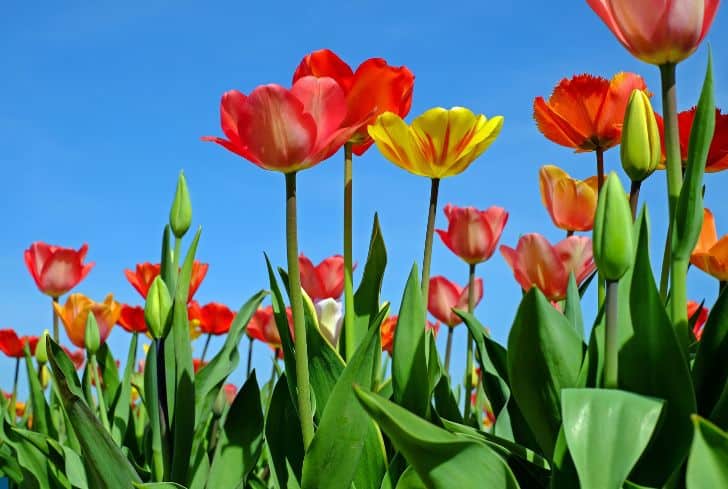Understanding Tulip Life Cycles
Tulips, like many other perennial flowers, undergo a unique life cycle that determines their ability to return year after year. This cycle consists of three primary stages: growth, blooming, and dormancy. During the growth stage, tulips develop their roots, stems, and leaves, typically in the spring and summer months. As the plants mature, they enter the blooming stage, where they produce vibrant flowers that attract pollinators and add color to the garden. After the blooming period, tulips enter a state of dormancy, where they conserve energy and prepare for the next growing season.
Understanding these stages is crucial in answering the question, “do tulips come back every year?” By recognizing the different phases of a tulip’s life cycle, gardeners can take steps to promote healthy growth, encourage repeat blooms, and ensure a vibrant display year after year. This foundation of knowledge will help gardeners address the key factors that influence a tulip’s ability to return annually, including climate, soil quality, and proper care.
Do Tulips Come Back Year After Year?
The answer to this question is a resounding “yes,” but with certain conditions. Tulips are perennial flowers, meaning they have the potential to return year after year, but their ability to do so depends on various factors. Climate, soil quality, and proper care are all crucial elements that influence a tulip’s ability to come back annually. In regions with mild winters and cool summers, tulips are more likely to return year after year, as they can complete their life cycle without interruption. Similarly, tulips planted in well-draining soil with the right pH level and adequate sunlight are more likely to thrive and return.
Proper care, including deadheading, fertilizing, and dividing, also plays a significant role in encouraging tulips to come back every year. By providing the right conditions and care, gardeners can increase the chances of their tulips returning year after year, and enjoying a vibrant and stunning display of color. So, do tulips come back every year? With the right combination of climate, soil, and care, the answer is a definite “yes.”
How to Encourage Tulips to Bloom Again
To ensure tulips come back year after year, it’s essential to promote healthy growth and encourage repeat blooms. One of the most critical steps in this process is deadheading, which involves removing the flower heads after they’ve bloomed. This simple yet effective technique directs the tulip’s energy towards re-growing and storing energy for next year’s bloom, rather than seed production. Additionally, fertilizing tulips during the growing season can provide them with the necessary nutrients to thrive and return.
Dividing and replanting tulips is another crucial step in encouraging repeat blooms. As tulips mature, they can become congested, which can lead to a decrease in blooming. By dividing and replanting every 3-4 years, gardeners can maintain healthy, vigorous plants that will continue to bloom year after year. It’s also essential to choose a location with adequate sunlight and well-draining soil, as these conditions will help promote healthy growth and increase the chances of tulips returning.
By following these simple yet effective tips, gardeners can encourage their tulips to bloom again and enjoy a vibrant display of color year after year. Remember, with proper care and attention, tulips can come back year after year, providing a stunning and long-lasting display in the garden.
The Role of Climate and Soil in Tulip Regrowth
Climate and soil conditions play a significant role in tulip regrowth, and understanding these factors is crucial for ensuring tulips come back year after year. Tulips thrive in regions with cool winters and mild summers, as this allows them to complete their life cycle without interruption. In areas with extreme temperatures, tulips may struggle to survive, let alone return.
Soil quality is also essential for tulip regrowth. Tulips prefer well-draining soil with a pH between 6.0 and 7.0. Soil that is too dense or prone to waterlogging can cause tulips to rot, while soil that is too dry can lead to poor growth. By choosing tulip varieties suitable for your region and soil type, gardeners can increase the chances of their tulips returning year after year.
For example, Darwin Hybrids and Fosteriana Tulips are popular varieties that thrive in cooler climates, while Species Tulips are more tolerant of warmer temperatures. By selecting the right variety for your region, gardeners can ensure their tulips receive the conditions they need to return year after year. By understanding the role of climate and soil in tulip regrowth, gardeners can take the necessary steps to create an ideal environment for their tulips to thrive.
Tulip Care Mistakes to Avoid
While tulips are relatively low-maintenance, there are some common mistakes that can prevent them from returning year after year. One of the most critical mistakes to avoid is overwatering, which can cause tulip bulbs to rot. On the other hand, underwatering can also hinder tulip growth and prevent them from blooming. It’s essential to strike a balance and provide tulips with consistent moisture, especially during the growing season.
Inadequate sunlight is another common mistake that can prevent tulips from returning. Tulips need at least six hours of direct sunlight per day to thrive, so it’s essential to choose a location that receives sufficient sunlight. Additionally, failing to deadhead tulips after they’ve bloomed can prevent them from storing energy for next year’s bloom, reducing the chances of them coming back year after year.
Other mistakes to avoid include planting tulips too deeply, which can cause them to rot, and not providing enough space between bulbs, which can lead to overcrowding and reduced growth. By being aware of these common mistakes and taking steps to avoid them, gardeners can increase the chances of their tulips returning year after year and enjoying a vibrant and long-lasting tulip display.
Preparing Tulips for Winter
As the growing season comes to an end, it’s essential to prepare tulips for winter to ensure they come back year after year. One of the most critical steps is to cut back the foliage to about an inch or two above the soil surface. This helps to prevent disease and pests from overwintering and reduces the risk of rot.
Adding a layer of mulch around the tulip bed can also help to protect the bulbs from extreme temperatures and prevent them from heaving out of the soil during the winter months. A 2-3 inch layer of organic mulch such as straw or bark chips is ideal. Additionally, consider applying a low-nitrogen, high-potassium fertilizer to the soil before the winter to promote healthy bulb growth.
In regions with extremely cold winters, it may be necessary to provide additional protection for tulips. This can include covering the bed with a layer of burlap or a cold frame to keep the soil from freezing. By taking these steps, gardeners can ensure their tulips are well-prepared for the winter months and will come back strong and healthy in the spring, ready to bloom again and do tulips come back every year.
Tulip Varieties That Come Back Year After Year
While many tulip varieties are bred for their stunning blooms, some are particularly well-suited to returning year after year. Darwin Hybrids, for example, are known for their vibrant colors and ability to naturalize, making them an excellent choice for gardeners looking to create a long-lasting tulip display. Fosteriana Tulips, with their large, cup-shaped blooms, are another popular variety that tends to come back year after year with proper care.
Species Tulips, such as the Tulipa tarda and Tulipa turkestanica, are also known for their ability to return year after year. These varieties tend to be more low-maintenance than other types of tulips and are often less susceptible to disease and pests. By choosing tulip varieties that are known to come back year after year, gardeners can increase their chances of enjoying a vibrant and long-lasting tulip display, and do tulips come back every year.
In addition to choosing the right variety, it’s essential to provide tulips with the proper care and conditions to ensure they come back year after year. This includes planting them in well-draining soil, providing adequate sunlight and water, and fertilizing them regularly. By combining the right tulip variety with proper care, gardeners can enjoy a stunning tulip display for years to come.
Conclusion: Enjoying a Vibrant Tulip Display Year After Year
In conclusion, ensuring that tulips come back every year requires a combination of proper care, suitable climate and soil conditions, and choosing the right tulip varieties. By understanding the different stages of a tulip’s life cycle, providing the necessary care and attention, and avoiding common mistakes, gardeners can enjoy a stunning and long-lasting tulip display. Remember, do tulips come back every year? With the right approach, the answer is a resounding yes!
By following the tips and best practices outlined in this article, gardeners can create a vibrant and thriving tulip garden that will return year after year. From deadheading and fertilizing to preparing tulips for winter and choosing the right varieties, every step plays a crucial role in ensuring a successful tulip display. By implementing these tips and avoiding common mistakes, gardeners can enjoy a beautiful and long-lasting tulip display that will bring joy and beauty to their outdoor space for years to come.








